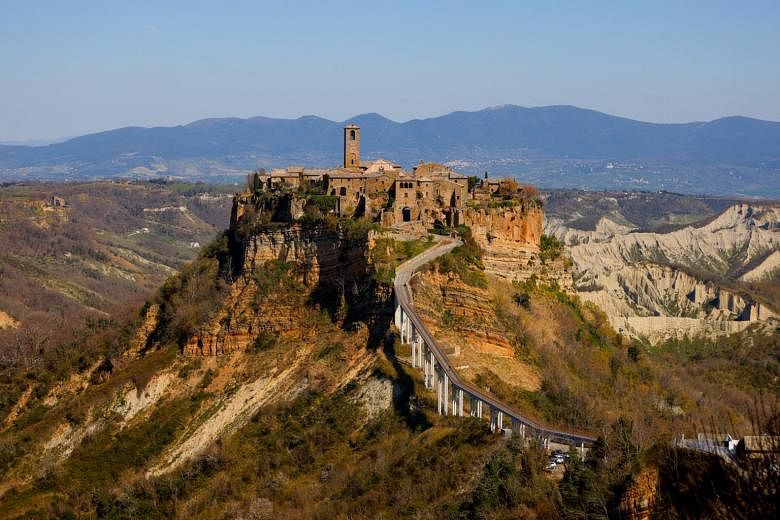CIVITA DI BAGNOREGIO, ITALY (REUTERS) - Calling yourself "The Dying Town" may not sound like the best way of attracting visitors, but a hilltop town in central Italy has learnt to make a living out of dying.
And it has resisted definitive death for so long that Italy has nominated the town called Civita and the surrounding area of stark cliffs and valleys known as "badlands" to be a United Nations Educational, Scientific and Cultural Organisation (Unesco) World Heritage Site.
Centuries ago, the town was much larger and connected by road to other settlements. But landslides, earthquakes, cracks and erosion have reduced its size dramatically and left it sitting spectacularly alone at the top of a spur.
When winter clouds are low, Civita looks like a floating castle in the air. On a clear day, the rock on which it rests looks like a slice of a multi-layered cake.
Clay from an inland sea a million years ago supports strata of compacted ash and magma from subsequent volcanic eruptions.
Civita's past, present and future are the stuff of a geologist's dream, with a major landslide that occurred in 1114 still under study today.
"During three millennia, regressive erosion has practically reduced Civita to a nucleus, leaving the square and a few streets around it," said geologist Luca Costantini, who is part of a project to monitor and slow down the erosion.
In underground caverns cut out of soft volcanic rock known as tufo, steel bars hold walls together.
"Our motto is 'resilience' because Civita was founded by the Etruscans, passed through the Roman era and the entire medieval period to reach the present day," said Mr Luca Profili, the mayor of Bagnoregio, of which Civita is a part.
"This place is so fragile," he said.
That fragility is measured in part by an "extensometer", an external telescopic rod that detects movement.
The Civita that remains today is mostly from the Medieval period and measures about 152m by 91m, less than two soccer pitches. Its main square is about the size of a basketball court.
Once spread out on a hill about three times its current size, over the centuries entire neighbourhoods collapsed in landslides. Today, it is accessible via a long and steep ramp for pedestrians or golf carts.

The number of permanent residents fluctuates between 10 and 14 depending on the season. Before the pandemic, Civita was a draw for tourists travelling between Rome and Florence.
Road signs direct visitors to "Civita - The Dying Town".
Mr Stefano Lucarini, 29, bought a restaurant in Civita in March 2020, just days before the first Covid-19 lockdown.
"The timing was not great," he said. But he is optimistic that after the pandemic, the town can get back on its feet.
"The environmental risk is worrying (but) we hope that for many years everyone will be able to enjoy the town," he said.
The mayor's spokesman, Mr Roberto Pomi, said Italy submitted the heritage site proposal in January and expects Unesco to decide in June next year.

